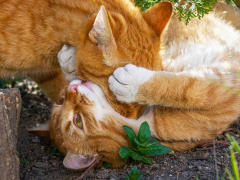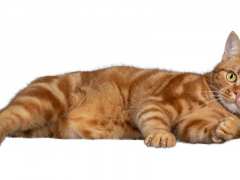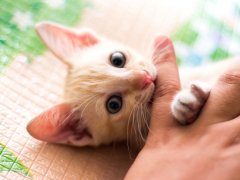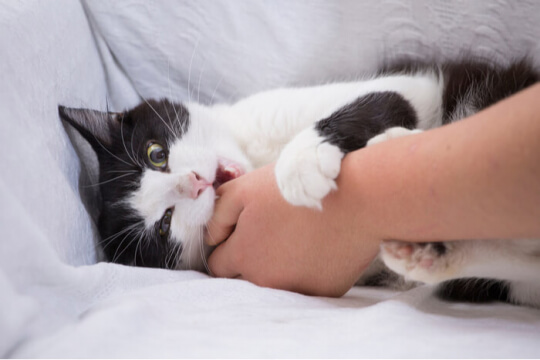
We love interacting and spending time with our cats whether through petting, holding, playing or training, but what happens when our cat isn’t in the mood, defensive or in pain, and bites us? In this article, we’ll explore the answers to the question “why does my cat bite me for no reason?” to better understand why cats bite and what to do when biting happens.
‘Aggression’ is serious and may lead to injury to people, and other pets, moreover zoonosis can transmit from cats to people through aggressive acts.
Understanding the cat’s normal social behaviour, communication, facial expressions and feline emotions can prevent hostile behaviour towards carers.
Let’s explore why cats bite humans and how to tell if your cat gives you ‘love bites’ or nips due to frustration or discomfort.
Understanding ‘Aggression’
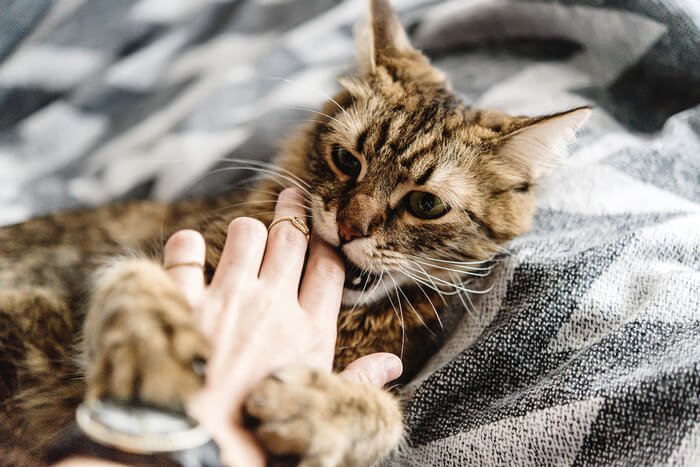
In order to understand why your cat bites you, you need to understand why cats exhibit aggressive behaviors in general.
Aggressive responses are related to innate behaviour of cats and a normal part of predation, play and social conflict which are all essential for survival of a territorial, independent, solitary hunter.
Aggression isn’t a temperament trait or a diagnosis, it’s a consequence of an emotional state.
While humans use feelings to describe how they feel, cats’ emotions are depicted as motivational-emotional systems, responsible for instinctual arousal instead of the feelings of emotion (Heath, 2018).
If a pet cat starts displaying aggression towards humans, then this represents a ‘problem behaviour’ needing distinctive assessment.
Aggression in cats is typically related to:
- Genetics and former experiences. Genetic differences in temperament will affect how stressed a cat becomes in certain situations, how it reacts to a stressor, and the length of time a negative emotion lasts after the trigger has vanished. In addition to genetics, previous experiences play a role in individual’s flexibility to adopt to change.
- Lack of socialization. Hand-raised kittens and adult cats that haven’t been socialized with previous cats or handled by humans between 2 -14 weeks old tend to be more nervous, fearful, aggressive with a reduced ability to handle environmental alterations.
- Fear. Cats may react both offensively and defensively out of fear when they feel vulnerable, perceive a threat and imminent danger. The cat may respond in an aggressive manner by piercing if escape is unavoidable.
- Social conflict. Pet cats don’t have control of who they live with or which cats or other pets they share their home with, it’s evident some cats cope better with confinement and social living than others.
Reasons Why Cats Bite People
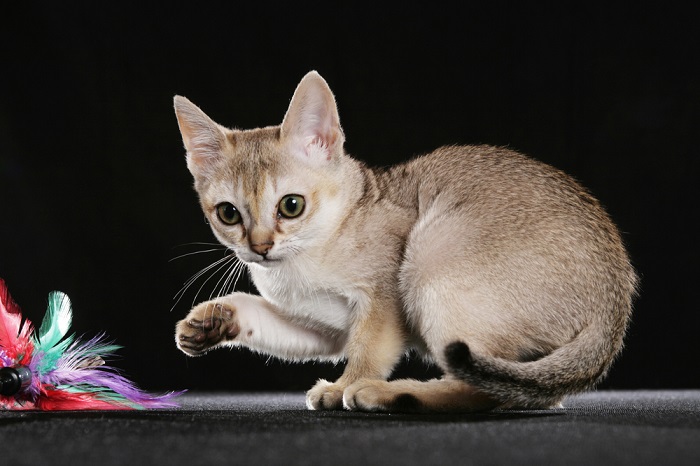
You can avoid the attack with short petting sessions or by giving your cat attention in other ways.
Cats may bite people for a variety of reasons, including improper play habits in childhood, overstimulation, affection, and more.Hostility toward people is a common cat behaviour problem. Categories include but aren’t limited to:
1. Improper Kitten Play
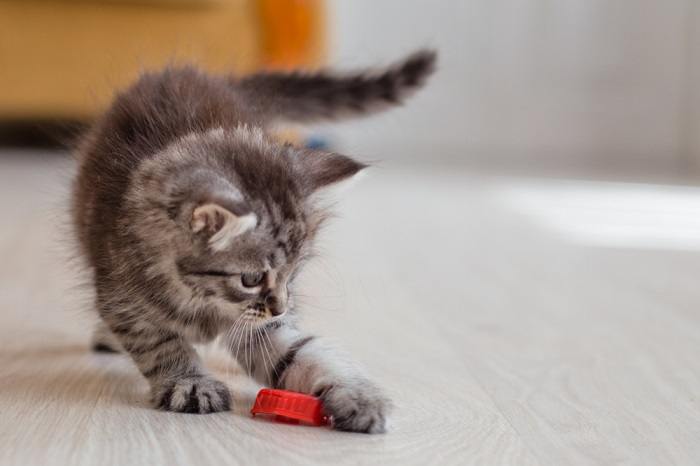
Petting-induced belligerence is annoying and upsetting to pet owners. It’s usually related to cats who become less tolerant of petting as they socially mature.
Kittens who engage in rough fights during kittenhood are usually disrupted by mum if it becomes a touch vicious, teaching bite inhibition.
Social play includes wrestling, pouncing, piercing and episodes of play-fighting. Inadvertently, when humans attempt similar type games using their hands, reinforce its excitable behaviour encouraging kittens to grow into adult felines who pounce on hands and feet once they want play or attention.
2. Petting ‘Aggression’
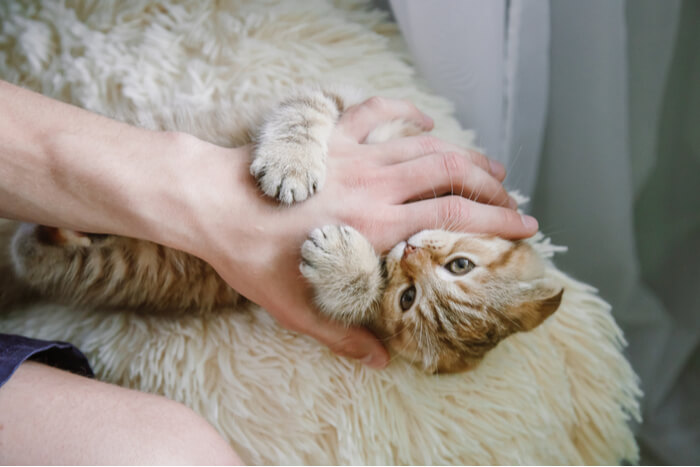
Cats will occasionally bite when they’re pet in a way that is overstimulating or makes them feel vulnerable.
Petting-induced resentment happens when a cat solicits attention by being petted in part of their body that creates him or her feel vulnerable (belly, chest or back), then abruptly stops the interaction with clawing or stinging. Usually, the cat becomes overstimulated or agitated needing to stop the interaction.
Also Read: How To Pet A Cat – The 3 Basic Do’s And Don’t’s
Petting-induced belligerence is annoying and upsetting to pet owners. It’s usually related to cats who become less tolerant of petting as they socially mature. You can avoid the attack with short petting sessions or by giving your cat attention in other ways.
3. Redirected Frustration
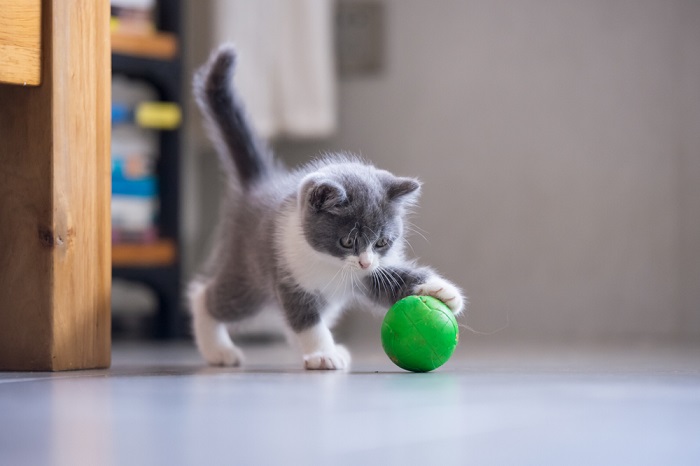
Socializing cats to a variety of individuals and situations can prevent varieties of human-directed violence.
If a cat is extremely aroused by an outdoor moggie or an event, may redirect their hostility towards another pet or unsuspected nearby owner.
The stressful stimulus or the presence of the owner will activate the tension response leading towards an attack. Never try to handle your cat during this aroused state since it can cause serious injury.
4. Medical and Painful Conditions
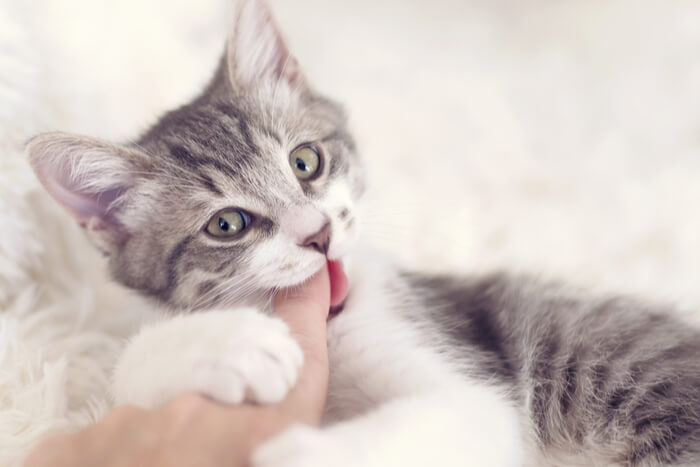
Cats will sometimes bite or exhibit other aggressive behaviors because they are in pain.
Confession time – my female cat has pain associated aggression; it took me a long time to work it out after multiple grips and vet visits. A cat who is sick or in pain may attack their owner (unintentionally) if approached or touched in an exceedingly vulnerable spot.
In my case, mild touch on her arthritic hips or brushing her lower spine caused her to react with antagonism.
Both acute and chronic pain can prompt tactile sensitivity and biting. Painful conditions like dental disorders, Degenerative Joint Disease (DJD), meningioma, Intervertebral Disk Disease (IVDD), FIC, wound or injury often induce a negative emotional state of anxiety and/or frustration and should prompt owners to seek immediate veterinary assistance.
What To Do If Your Cat Bites You?
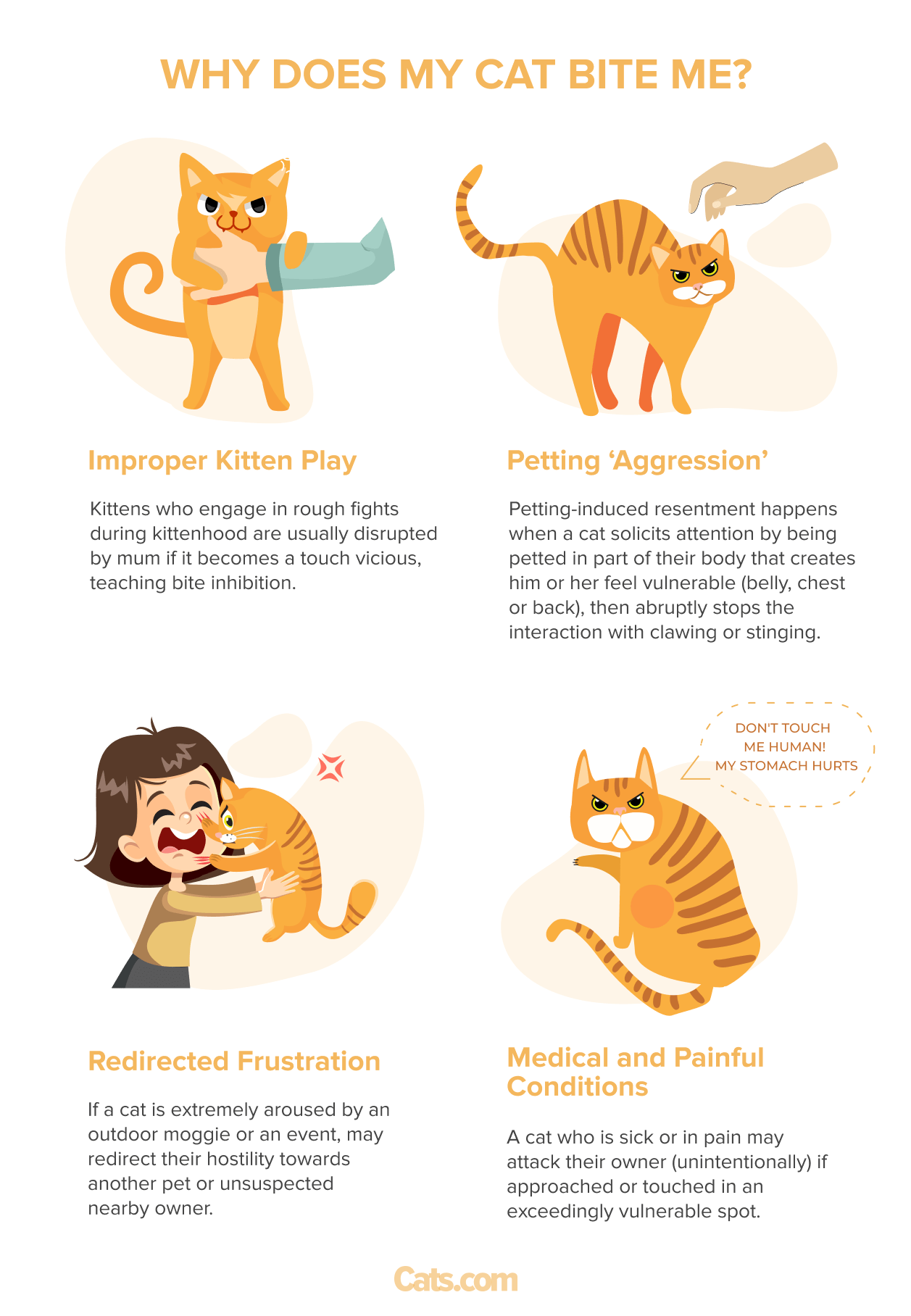
Safety and prevention of further injury is paramount. Stop interacting with your cat and leave immediately.
Don’t shout, touch or punish your cat, especially if it’s in a highly aroused state (aggressive vocalization/body language, behaving uncharacteristically).
If possible, separate the cat from humans, children, and other pets in a different room with lights deemed off. Once the cat is safe, treat all wounds plus seek medical advice instantly.
Usually, cats calm down within a few hours. Stop initiating any contact, allow your cat to decide on when to interact and for how long. This can cause you to appear less intimidating and meddling.
A few days later, start desensitization and counter-conditioning your cat gradually to touch and handling, which should deepen the human-animal bond. If your cat demonstrates fearfulness or ‘aggression’ when touched, seek help from a certified behaviour consultant or a veterinary behaviorist.
Lastly, take your cat to the vet for an in-depth examination to rule out an underlying medical reason.
How To Stop And Prevent Cat Biting?
Don’t Let Your Kitten Bite Your Hands Or Feet!
Kittens are super energetic and love playing. Avoid luring your kitty to play by jiggling your fingers or toes, then get dismayed when he or she scratches or prick you. If your kitten attempts to nibble body parts, look or step away before giving them attention.
Also Read: How To Take Care Of A Kitten: The Complete Guide
Always offer your moggie appropriate toys as a substitute, rotate games as much as possible since cats like novelty objects.
Avoid stroking or picking the kitten during or after playtime because it might unintentionally encourage the kitten to think hands are toys. Hands are for loving – not for nipping!
If your kitten persistently nips, discourage him or her by blowing sharply but gently on the kitten’s face.
Expose young cats to gentle, positive body handling to make sure they grow into adults who enjoy being stroked.
Pay attention to areas your individual cats likes to be stroked, only pet him or her where they’re comfortable.
Most cats prefer short sessions (seconds) of touch on parts of their body where scent glands are located such as the top of their head, cheeks and chin. Certain cats like quick, short strokes whilst others slower, longer strokes.
Watch out for warning signs of agitation like tail swishing, piloerection, skin twitching, sudden vocalization, cat looking back at you and position shifting.
It’s important our cats learn to cope with unavoidable events life throws at them. There could also be situations needing vet visits, grooming, medication or just meeting unannounced visitors. Socializing cats to a variety of individuals and situations can prevent varieties of human-directed violence.
Use Redirection Training

Set up an enriched environment to improve physical activity, mental stimulation, decrease boredom, and prevent behaviour problems exhibited by under-stimulated cats.
Redirect undesired behaviour with clicker along with target training and reward with treats or positive attention to encourage desired behaviour.
Environmental Adjustments Can Also Help
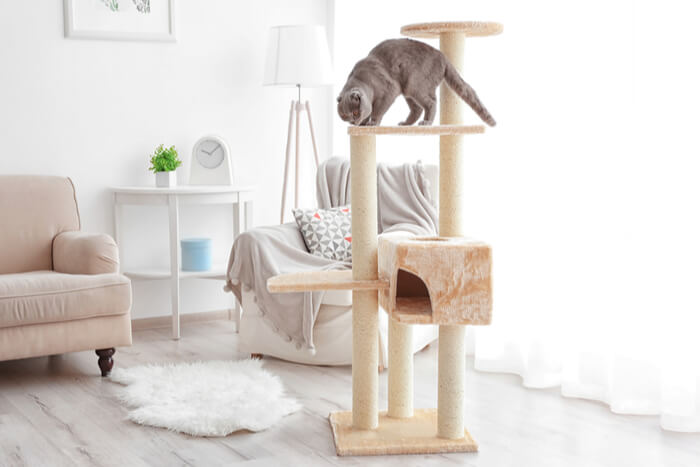
Providing an enriched environment—one with cat trees, shelves, and toys—can help to prevent biting and other forms of unwanted behavior.
Set up an enriched environment to improve physical activity, mental stimulation, decrease boredom, and prevent behaviour problems exhibited by under-stimulated cats.
Frustrated, angry indoor cats should be given outdoor access (ideally unrestricted) with numerous opportunities for climbing, exploration and problem-solving possibilities.
Here are a few ways to enrich your cat’s environment:
Increase Hiding And Perching Spots
Increase the number of hiding spots, high perching areas, and quiet areas (cat castles, boxes) to assist your cat feel comfy and reduce competition in multi-cat homes. Viewing platforms will allow your cat to accustom to new places, noises, and experiences without the necessity to retreat.
Minimise Environmental Changes
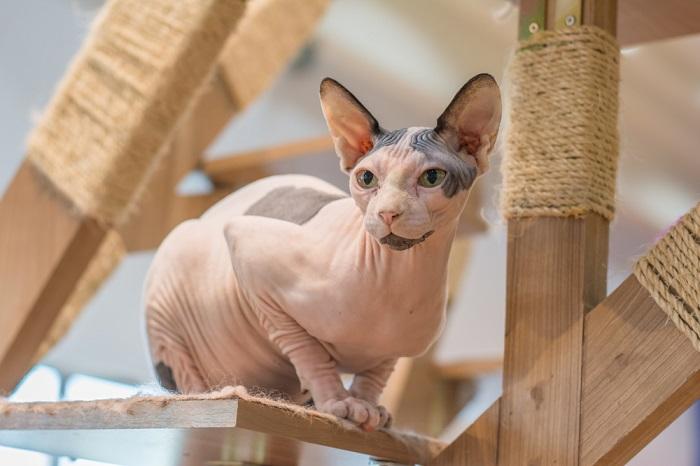
Viewing platforms will allow your cat to accustom to new places, noises, and experiences without the necessity to retreat.
Keep the house environment predictable with a sense of security. Regular and gradual environmental changes can help to keep your cat from startling easily. If you must make a sudden environmental change, try pheromone products to assist the reduction of fear-based aggression.
Provide Food Puzzles and Predatory Games

Ensure your cat has an appropriate outlet for hunting games each day. Avoid frustration-provoking play with laser pointers only.
Use food puzzles to resolve situations where the cat experiences frustration, when food isn’t easily obtainable or as a natural concept for hunting behaviour.
Ensure your cat has an appropriate outlet for hunting games each day. Avoid frustration-provoking play with laser pointers only.
Predation of hands and feet won’t occur once your cat has an opportunity for stalking games with toys like Hartz Just For Cats Kitty Caster Cat Wand Toy, Cat Dancer, and SmartyKatSkitter Critters Cat Toy. Follow play sessions with treats to finish the hunting sequence.
Also Read: The 10 Best Cat Slow Feeders & Puzzle Feeders
Residing in a domestic environment puts considerable pressure on pet cats. Enhancing their physical and social environment is each owner’s responsibility.
Cases involving human-directed ‘aggression’ are often tackled using a big selection of interventions. In some instances, behaviour modification and medication can also help.
-
Ellis, S. (2020, January). Understanding and recognising fear, anxiety and frustration. Feline Focus. (I. C. Care, Compiler) Tisbury, Wiltshire, UK. Retrieved December 08, 2020
-
Halls, V. (2020). I’m not bad, I just do bad things!’: Reframing our thoughts on aggressive cats. International Society of Feline Medicine Symposium (pp. 1-7). UK: ISFM. Retrieved December 18, 2020
-
Heath, I. R. (2016). Feline Behavioral Health and Welfare. St Louis, MO: Elsevier. Pg 73-77, 232-238, 376-382. Retrieved December 15, 2020
-
Heath, S. (2018). Understanding Feline Emotions and their role in problem behaviours. Journal of Feline Medicine and Surgery, 20, 437-444. Retrieved December 10, 2020
-
Helen Tuzio, T. E. (2004). FELINE BEHAVIOR GUIDELINES. (A. A. Practitioners, Compiler) USA: AAFP. Retrieved December 08, 2020
-
Miller, P. G. (2020, December 07). Training Cats. Barks from the Guild. (B. Magazine, Compiler) USA.
-
Rodan, D. F. (2018). Behavioral Awareness in the Feline Consultation - Understanding physical and emotional health. Journal of Feline Medicine and Surgery, 20, 423-436. Retrieved December 12, 2020
-
Stanslaski, J. (2020). Why does my cat - Curious and odd behaviours of our feline companions. International Society of Feline Medicine Symposium (pp. 9-13). ISFM. Retrieved December 12, 2020

